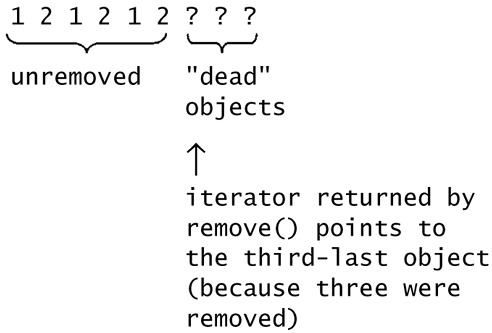Solution
| I l @ ve RuBoard |
What remove() Removes
The standard algorithm remove() does not physically remove objects from a container; the size of the container is unchanged after remove() has done its thing. Rather, remove() shuffles up the "unremoved" objects to fill in the gaps left by removed objects, leaving at the end one "dead" object for each removed object. Finally, remove() returns an iterator pointing at the first "dead" object, or, if no objects were removed, remove() returns the end() iterator. For example, consider a vector<int> v that contains the following nine elements: 1 2 3 1 2 3 1 2 3 Say that you used the following code to try to remove all 3's from the container: // Example 2-1 // remove( v.begin(), v.end(), 3 ); // subtly wrong What would happen? The answer is something like this: Three objects had to be removed, and the rest were copied to fill in the gaps. The objects at the end of the container may have their original values (1 2 3), or they may not; don't rely on that. Again, note that the size of the container is left unchanged. If you're wondering why remove() works that way, the most basic reason is that remove() doesn't operate on a container, but rather on a range of iterators, and there's no such iterator operation as "remove the element this iterator points to from whatever container it's in." To do that, we have to actually get at the container directly. For further information about remove() , see also Andrew Koenig's thorough treatment of this topic in [Koenig99].
Here's a one-liner to do it, where v is a vector<int> : // Example 2-2: Removing 3's from a vector<int> v // v.erase( remove( v.begin(), v.end(), 3 ), v.end() ); The call to remove( v . begin(), v . end(), 3 ) does the actual work, and returns an iterator pointing to the first "dead" element. The call to erase() from that point until v . end() gets rid of the dead elements so that the vector contains only the unremoved objects.
// Example 2-3(a) // // Method 1: Write a special-purpose // remove_nth algorithm. // template<typename FwdIter> FwdIter remove_nth( FwdIter first, FwdIter last, size_t n ) { /* ... */ } // Example 2-3(b) // // Method 2: Write a function object which returns // true the nth time it's applied, and use // that as a predicate for remove_if. // class FlagNth { public: FlagNth( size_t n ) : current_(0), n_(n) { } template<typename T> bool operator()( const T& ) { return ++current_ == n_; } private: size_t current_; const size_t n_; }; // Example invocation ... remove_if( v.begin(), v.end(), FlagNth(3) ) ...
People often propose implementations that have the same bug as the following code. Did you? // Example 2-3(c): Can you see the problem(s)? // template<typename FwdIter> FwdIter remove_nth( FwdIter first, FwdIter last, size_t n ) { for( ; n > 0; ++first, --n ) ; if( first != last ) { FwdIter dest = first; return copy( ++first, last, dest ); } return last; } There is one problem in Example 2-3(c), and that one problem has two aspects:
Here is a reasonable implementation: // Example 2-3(d): Solving the problems // // Precondition: // - n must not exceed the size of the range // template<typename FwdIter> FwdIter remove_nth( FwdIter first, FwdIter last, size_t n ) { // Check precondition. Incurs overhead in debug mode only. assert( distance( first, last ) >= n ); // The real work. advance( first, n ); if( first != last ) { FwdIter dest = first; return copy( ++first, last, dest ); } return last; }
Method 1 has two main advantages:
Method 2 has corresponding disadvantages, which we'll analyze in detail in the second part of this miniseries. |
| I l @ ve RuBoard |
EAN: 2147483647
Pages: 118
